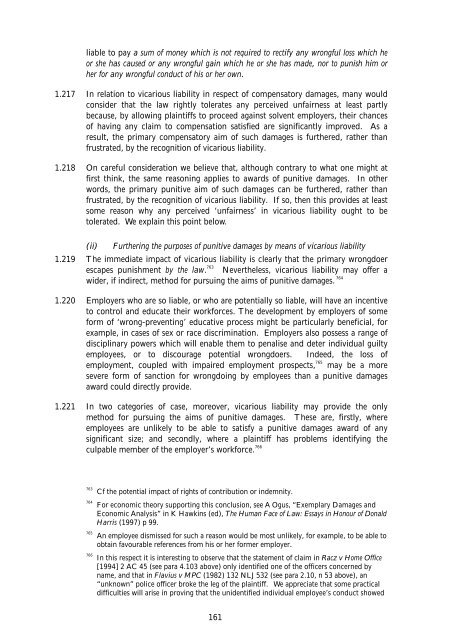Aggravated, Exemplary and Restitutionary ... - Law Commission
Aggravated, Exemplary and Restitutionary ... - Law Commission
Aggravated, Exemplary and Restitutionary ... - Law Commission
Create successful ePaper yourself
Turn your PDF publications into a flip-book with our unique Google optimized e-Paper software.
liable to pay a sum of money which is not required to rectify any wrongful loss which he<br />
or she has caused or any wrongful gain which he or she has made, nor to punish him or<br />
her for any wrongful conduct of his or her own.<br />
1.217 In relation to vicarious liability in respect of compensatory damages, many would<br />
consider that the law rightly tolerates any perceived unfairness at least partly<br />
because, by allowing plaintiffs to proceed against solvent employers, their chances<br />
of having any claim to compensation satisfied are significantly improved. As a<br />
result, the primary compensatory aim of such damages is furthered, rather than<br />
frustrated, by the recognition of vicarious liability.<br />
1.218 On careful consideration we believe that, although contrary to what one might at<br />
first think, the same reasoning applies to awards of punitive damages. In other<br />
words, the primary punitive aim of such damages can be furthered, rather than<br />
frustrated, by the recognition of vicarious liability. If so, then this provides at least<br />
some reason why any perceived ‘unfairness’ in vicarious liability ought to be<br />
tolerated. We explain this point below.<br />
(ii) Furthering the purposes of punitive damages by means of vicarious liability<br />
1.219 The immediate impact of vicarious liability is clearly that the primary wrongdoer<br />
escapes punishment by the law. 763<br />
Nevertheless, vicarious liability may offer a<br />
wider, if indirect, method for pursuing the aims of punitive damages. 764<br />
1.220 Employers who are so liable, or who are potentially so liable, will have an incentive<br />
to control <strong>and</strong> educate their workforces. The development by employers of some<br />
form of ‘wrong-preventing’ educative process might be particularly beneficial, for<br />
example, in cases of sex or race discrimination. Employers also possess a range of<br />
disciplinary powers which will enable them to penalise <strong>and</strong> deter individual guilty<br />
employees, or to discourage potential wrongdoers. Indeed, the loss of<br />
employment, coupled with impaired employment prospects, 765<br />
may be a more<br />
severe form of sanction for wrongdoing by employees than a punitive damages<br />
award could directly provide.<br />
1.221 In two categories of case, moreover, vicarious liability may provide the only<br />
method for pursuing the aims of punitive damages. These are, firstly, where<br />
employees are unlikely to be able to satisfy a punitive damages award of any<br />
significant size; <strong>and</strong> secondly, where a plaintiff has problems identifying the<br />
culpable member of the employer’s workforce. 766<br />
763 Cf the potential impact of rights of contribution or indemnity.<br />
764 For economic theory supporting this conclusion, see A Ogus, “<strong>Exemplary</strong> Damages <strong>and</strong><br />
Economic Analysis” in K Hawkins (ed), The Human Face of <strong>Law</strong>: Essays in Honour of Donald<br />
Harris (1997) p 99.<br />
765 An employee dismissed for such a reason would be most unlikely, for example, to be able to<br />
obtain favourable references from his or her former employer.<br />
766 In this respect it is interesting to observe that the statement of claim in Racz v Home Office<br />
[1994] 2 AC 45 (see para 4.103 above) only identified one of the officers concerned by<br />
name, <strong>and</strong> that in Flavius v MPC (1982) 132 NLJ 532 (see para 2.10, n 53 above), an<br />
“unknown” police officer broke the leg of the plaintiff. We appreciate that some practical<br />
difficulties will arise in proving that the unidentified individual employee’s conduct showed<br />
161
















